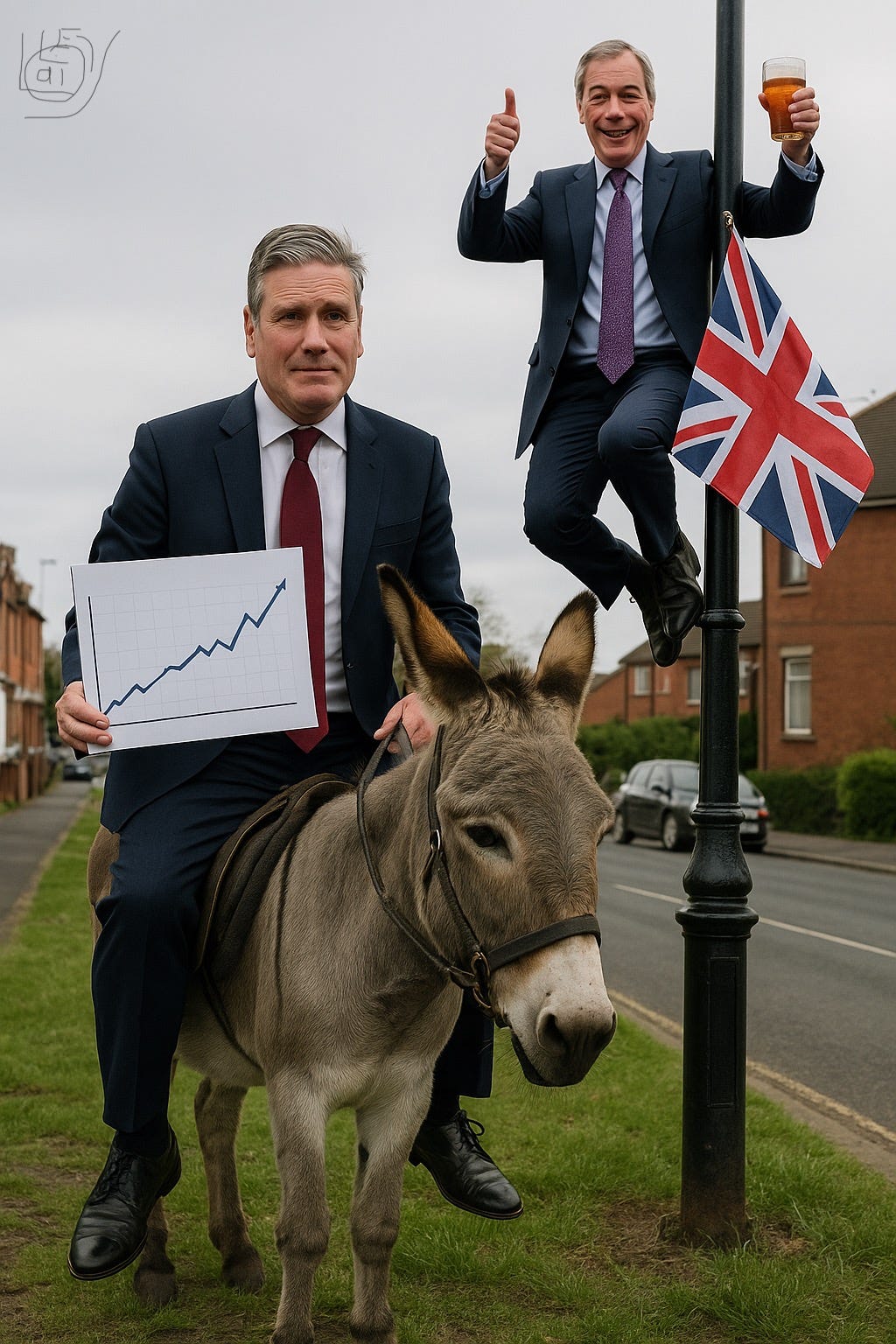When the Graphs Lie and the Lamp Posts Tell the Truth
Polls twitch like weather vanes. Lamp posts, by contrast, are stubborn barometers. They don’t spin at every gust of opinion.
A rare smile flickered across Keir Starmer’s face as Laura Kuenssberg pressed him on Sunday Politics. For once he drifted from script. He spoke of his one-legged mum, of four donkeys grazing in a field he’d bought, and admitted — almost awkwardly — that his lawyer’s pay had made it possible
.Was it rehearsed? Maybe. But it was convincing. For a brief moment, Starmer felt less like the forensic lawyer and more like a man with a story, a memory, a scrap of humour. That is precisely what Labour’s annual conference in Liverpool cries out for this week: a leader who can show voters he is not only diligent and dry, but human, relatable, even likeable.
The trouble is, the rest of the interview was pure Starmer: careful, evasive, grey. He answered the questions he wanted, not the ones asked. He wrapped himself back in graphs and talking points. And graphs don’t win elections. Lamp posts do.
The Donkey Test
For years Starmer floated on polls that put Labour safely ahead. Those days feel like a different era. Reform UK is now rising into double digits, gnawing away at disillusioned Conservatives and tempting some traditional Labour voters too. Loyalists mutter about “rogue polls,” but when Nigel Farage’s weekend army is beating you in snapshots, that isn’t rogue. That’s reality.
Polls twitch like weather vanes. Lamp posts, by contrast, are stubborn barometers. They don’t spin at every gust of opinion. They bear flags, stickers, graffiti, flyers — and they remain until someone physically rips them down. They show who holds ground in neighbourhoods, not just who ticks boxes online.
Inside the Liverpool conference, Labour’s branding is immaculate. Bright red banners, “Renew Britain” slogans, glossy graphics on the giant screen. It is politics as stagecraft. Step outside the bubble and the picture shifts. In Dudley, a St George’s flag still flaps above a terrace. In Stoke, a bus stop is marked with “Labour Out.” In Wolverhampton, Reform flyers sit on chip shop counters. One world is polished and planned. The other is scruffy but authentic. Which one do voters believe?
Graphs vs. Streets
This is why bookmakers, who sense mood rather than methodology, have shortened odds on Labour faltering. Reform may bleed Tory votes, but Starmer still struggles to look like the stronger alternative. Punters in Ladbrokes often feel the current before pollsters detect it.
That is the backdrop to Starmer’s sharper edge in Liverpool. He branded Farage’s plan to deport people already settled in Britain as “racist” and warned it would tear communities apart. His allies piled in: Shabana Mahmood called Farage “worse than racist” for his dog-whistle politics. The hall cheered. The press gallery scribbled. For a brief window, it looked as if Starmer had found his fight.
But the test is whether those lines travel beyond the conference hall. Do they echo in Dudley pubs, in Kent terraces, in Birmingham estates? Or do they remain trapped in the chamber, a closed loop of clapping delegates and recycled soundbites? Because while Starmer thundered in Liverpool, the lamp posts across the Midlands and North still carried a different verdict. And lamp posts outlast headlines.
The Starmer Bubble
Starmer’s personal strengths are plain. He is decent, serious, the grown-up in the room compared with Farage’s pub-bore routine. But his team is the weakness. Too young, too green, too Twitter-led. They treat flags as though ignoring them makes them vanish. They think hashtags matter more than conversations in chip shops.
That bubble was visible all week in Liverpool. The stage was choreographed to the second. Rachel Reeves promised fiscal discipline, wrapped in hints of tax rises. She was heckled mid-speech by a pro-Palestine protester, and the interruption briefly punctured the set-piece. Delegates later voted through a motion declaring Israel’s actions in Gaza a genocide, directly against the leadership’s line. Andy Burnham felt compelled to remind restless activists that Starmer is still the leader.
All of that chaos was real politics: noisy, messy, unscripted. Yet the leadership’s instinct is always to smooth, to script, to deny the bumps. They live in graphs. The voters live in streets.
And it is in the streets that the battle with Farage will be fought. Farage does not need spreadsheets. He has lamp posts. He has the flags and the flyers and the pub talk. Labour has an Excel file and a slogan. Which is more convincing at midnight on a rainy Dudley doorstep?
The Donkey vs. the Pub Bore
That donkey story matters more than it seems. Because it proved Starmer can step outside his lawyerly comfort zone. He can tell a tale, admit to a flaw, drop the mask. The room relaxed when he did it.
Farage does that every time he speaks, pint in hand, grin on face, outrageous claim on his lips. He is reckless, divisive, irresponsible. But he feels human. Starmer, by contrast, feels safe, evasive, tidy. The donkey moment showed he doesn’t have to.
If he wants to beat Farage, he must show not only that Farage is wrong, but that he himself is real.
A Last Chance
Politics isn’t only policy. It is symbol, ritual, image. Voters forgive mistakes when they feel respected. They punish you when they feel ignored.
That is why Reform’s hollow flag-waving cuts through, while Labour’s graphs fall flat.
Starmer still has time. His attack on Farage may be the first step in a harder, more human strategy. But he cannot afford to retreat into spreadsheets and scripts. The donkey showed him the way: a scrap of humour, a touch of memory, a glimpse of the man behind the lawyer.
If he remembers the donkey more than the graph, he may yet climb. If he forgets, then the lamp posts will write the verdict long before polling day.



